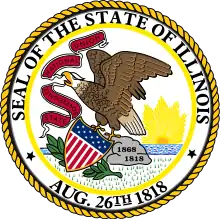Fox River Grove, Illinois
Fox River Grove (FRG) is a village in Algonquin Township, McHenry County and Cuba Township, Lake County, Illinois, United States. In 1919, the village of Fox River Grove officially incorporated, becoming the ninth village in McHenry County. The Grove is situated along the southern shore of the Fox River. The population was 4,854 at the 2010 census.[3] Residents refer to themselves as "Grovers."
Fox River Grove | |
|---|---|
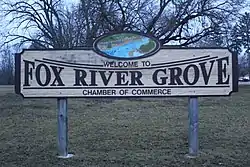 Village sign in Lions Park | |
 Flag | |
| Nickname(s): FRG, The Grove, The Great Town | |
 Location of Fox River Grove in McHenry County and Lake County, Illinois. | |
.svg.png.webp) Location of Illinois in the United States | |
| Coordinates: 42°11′44″N 88°13′0″W | |
| Country | United States |
| State | Illinois |
| County | McHenry, Lake |
| Founded | 1919 |
| Government | |
| • Type | Village |
| • Village president | Robert Nunamaker |
| Area | |
| • Total | 1.71 sq mi (4.43 km2) |
| • Land | 1.71 sq mi (4.43 km2) |
| • Water | 0.00 sq mi (0.00 km2) |
| Elevation | 817 ft (249 m) |
| Population (2010) | |
| • Total | 4,854 |
| • Estimate (2019)[2] | 4,573 |
| Time zone | UTC-6 (CST) |
| • Summer (DST) | UTC-5 (CDT) |
| ZIP Code(s) | 60021 |
| Area code(s) | 847 |
| FIPS code | 17-27533 |
| Wikimedia Commons | Fox River Grove, Illinois |
| Website | www |
History
Indigenous peoples
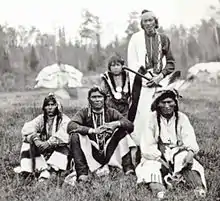
Long before the arrival of Europeans, Native Americans called the land within Fox River Grove home. The Ojibwe (also known as Chippewa) people continued to winter in the Fox River Valley into the 1860s. The women traded beadwork and purses with local settlers while the men trapped muskrat and mink, selling the pelts in nearby Barrington, Illinois. The area's proximity to Northwest Highway (Route 14), a major military and trade road, enabled such commerce to thrive. The men also made fence posts for local farmers and would "spear fish at night using torches attached to the end of their birchbark canoes."[4] When spring came, they traveled north to their summer lands in Wisconsin.[5] Between 1816 and 1833, the Ojibwe and U.S. government engaged in peace talks, resulting in several land cession treaties being signed. Eventually, all Ojibwe land in Illinois was taken by the federal government. The rapid increase of European-American settlers, coupled with pressures from the government and military, eventually forced this dynamic and proud people to leave the lands that would soon become FRG and relocate west of the Mississippi River.[6]
Czech heritage
Pioneers built homesteads in the Fox River Valley between 1830 and 1860. They were originally drawn to the area that would become Fox River Grove for its scenery and abundance of water.[7] Some of the first settlers to call the Grove home were Czechoslovakian immigrants who—by way of Chicago—established a Bohemian enclave along the Fox River. Attracted to the area for its prime fishing spots and access to 19th-century entertainment venues, Czechs built cottages among the village's hills and on the river's southern bank.[8]
In 1850, ethnically-Czech Frank Opatrny purchased 80 acres (320,000 m2) of land on the southern shore of the Fox River. Considered to be the patriarch of the village's founding family, Frank's son Eman Opatrny put FRG on the map by turning his homestead into the regionally-known Picnic Grove.[9]
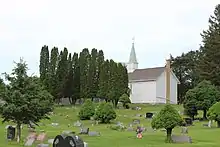
The Czech community established St. John's Nepomucene Catholic Church and Cemetery on the southwest fringe of Fox River Grove in 1861. Named after a patron saint of Bohemia, the sanctuary's construction began in 1871 and was finished in 1874. Because of the church's small congregation, St. John's did not support a resident priest. Instead, a Chicago-based priest would visit the congregation once a year; for the rest of the year, Bohemian-speaking members of the church would conduct services. While St. John's stopped hosting worship services in 1914, the cemetery remains open to this day.[10]
In 1900, Edward and Francis Konopasek (a Czech couple after whom one FRG's wards is named) built the Grove's first hotel—the Hotel Fox—and established a taxi service that shuttled notables like the Chicago Mayor Anton J. Cermak and Illinois Attorney General Otto Kerner Sr. from the nearest train stations to the Grove.[8]
FRG was once also home to a Czech-styled castle replete with 100 stained glass windows. It was built by John Legat Sr. in 1920, but most of the castle is now dismantled.[9]
Resort town period
Starting in the mid-nineteenth century, Czech immigrants transformed the Grove from a backwater pioneer settlement into a resort town. Chicagoans were attracted to the Grove's waterfront and surrounding hilly woodlands. Staying in establishments such as the Hotel Fox, Chicagoans traveled to the Grove via the Illinois & Wisconsin Railroad station and livery bus shuttle in neighboring Cary, Illinois.[11]
Picnic Grove heyday
In 1899, Eman Opatrny bought his father Frank's homestead and converted it into picnicking grounds. Known as the Fox River Picnic Grove, this large swath of land housed picnic plots (including sheltered areas), a shooting gallery, a horse track, six bars, a boathouse, boat docks, a dancing platform, a restaurant, a photo gallery, rowboat rentals, a bowling alley, a railroad spur track, a steam-powered excursion boat, and baseball diamonds. Trainloads of pleasure-seekers from Chicagoland would pour into the park for weekend getaways. Opatrny also built many cottages near the river's edge.
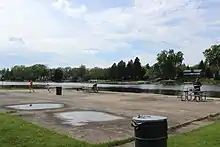
The Picnic Grove suffered a major blow in 1918 during a fire; most of the attractions from the early 1900s were lost. In 1942, Louis Jr. and Clara Cernocky purchased the Picnic Grove. The couple added more amenities, including a new dance pavilion, an air-conditioned cocktail lounge, and a 300-foot sandy beach. It fell into disarray in the 1960s. The Grove Marina, opened in 1961, was an entertainment center that included a restaurant and a cocktail lounge with live entertainment, but was destroyed by yet another fire in the mid-1970s.The Village of Fox River Grove obtained a grant to acquire 40 acres (160,000 m2) along the river in 1994, naming the property "Picnic Grove Park"; the rest of the land not purchased by the village was sold to subdivision developers.[12]
Other resort-era establishments
Besides the Picnic Grove, FRG welcomed the addition of a luxury hotel in 1902. Christened as the Castle Pavilion and Resort Hotel, the establishment had windows displayed during Chicago's 1893 Columbian Exposition, the area's first player piano, and a dance floor. During the 1910s, the Castle Pavilion even showed motion pictures, a novelty at the time.
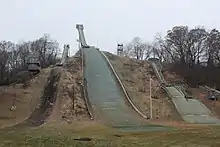
In 1905, a group of ethnically-Norwegian men from Chicago established the Norge Ski Club in FRG. Utilizing its three ski jumps, the club hosts international competitions during the winter months. The Norge Ski Club is the oldest continuously open ski club in the United States. During the spring and summer, snow is substituted by plastic tarps that are laid along the jumps. In the colder months, snow machines are employed to ensure that the slopes have a continual dusting of snow.[13] In 2018, three of its members were named to the men's U.S. Olympic ski jump team.[14][15]
Although it no longer stands, Fox-River Grove Inn - Louie's Place was an FRG mainstay for years. Built by Louis Cernocky Sr. at the corner of Northwest Highway and Lincoln Avenue, the establishment became a watering hole for many prominent Chicago residents and several notorious gangsters. Louie's Place also housed the Crystal Ballroom, an eight-sided dance hall built in 1923 where big-bands—including Glenn Miller, Coon-Sanders, Wayne King, Louis Panico, Fred Waring, Frankie Masters, Art Kassel, and Guy Lombardo—entertained patrons. In 1921, Cernocky added a retail section to the building, and in 1922 the plot of land was subdivided and named Cernocky's Subdivision of Block 12. In 1939, a suspicious fire broke out in the ballroom. A week later, four men saturated the ballroom with kerosene while their other two counterparts abducted the night watchman and a visiting fire marshall. These strange vandals fled by car towards Barrington, as their two planted bombs detonated at the scene of the crime. On the lam, the criminals released their captives near Palatine, Illinois. Although the explosions' resulting fire gutted the ballroom, the roof and the adjoining shops survived. The ballroom was repaired, but strangely enough, it never reopened for dancers.[16]
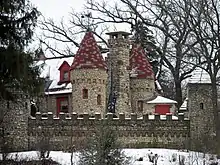
In 1931, Theodore "Teddy" Bettendorf began work on what would come to be known as Castle Vianden, which is located along what is now U.S. Route 14. Being an immigrant from Vianden, Luxembourg, Teddy spent 36 years building his castle in the Luxembourgian style. By 1960, the castle, which was open to visitors, had eight towers, a guard room, bugle tower, castle yard, enclosed sun porch, modern kitchen, garage, dungeon, and a wishing well. Bettendorff continued to add to his castle until his death in 1967. During the 1970s, the castle was rented out as a honeymoon retreat. The castle remains a private residence, but recently the owners of the property have been engaged in an ongoing effort to reopen the property for public enjoyment.[17]
In 1945, Fox River Grove established the first VFW post in McHenry County.
The Barberry Hills Ski Area—a ski hill complete with two rope tows, a vertical drop of 145 feet, and a ski shop—was established in the early 1960s. While the rope tows and shop are now defunct, the hill itself is still a destination for sledding in winter.[12]
Gang-related activity

During the Prohibition Era, FRG embodied the metaphorical underbelly of Northwest Chicagoland's crime syndicates. From bottom-rung bootleggers to the ringleaders themselves, gangsters of all stripes staked out the Grove for both business and merry-making. Located on the Fox River, the Grove served as a smuggling hub, with its waterways providing a transportation route. At the same time, the village's small and relatively remote nature helped to shelter gang activity from the Chicago Police Department and federal authorities. Above all, however, this criminals' playground was only made possible by Louis Cernocky Sr., a local legend to this day. Cernocky's property assets throughout FRG—along with his double-life stature as both a respected citizen and Capone gang bootlegger—allowed the operation to flourish.[18] Thanks to Cernocky, outlaws prowled the Fox River banks and frequented Cernocky's local establishments such as the Crystal Ballroom at Louie's Place—a multi-use establishment that served as a restaurant, big-band dance hall, speakeasy, and gangster hideout.[16] Importantly, members of the Dillinger Gang and Barker-Karpis Gang were regulars.[19] Notable gangster visitors to Louie's Place included Alvin "Creepy" Karpis, "Ma" Barker, Freddie Barker,[16] "Baby Face" Nelson, John Dillinger, Homer Van Meter, and Tommy Carroll. The Grove was finally released from the gangsters' grasp in 1934. Having already neutralized Dillinger in Chicago, federal agents pursued and fatally shot Baby Face Nelson on nearby Route 14 in The Battle of Barrington. With most of the ringleaders dead or behind bars, the Grove's gangster era soon came to an end.[18]
Suburban growth
During the economic prosperity of the 1990s, Fox River Grove experienced a housing boom. In 1994, 6 out of 7 of the village's trustees voted to allow a luxury housing development to be built on 62 acres within the 102-acre Picnic Grove—a stretch of land straddling the banks of the Fox River. Despite having the support of the Board of Trustees, the decision was deemed controversial by many members of the community.[20] The housing development was built, with requirements for developers including mandatory public space creation, specified amounts of money given to the local library and school districts, and the compulsory replacement of trees chopped down in the wake of new development.[21]
Level crossing accident
On October 25, 1995, a Metra passenger train, running express towards Chicago, collided with a Cary-Grove High School school bus, killing seven high school students. The accident brought reform and increased safety standards nationwide for signaled rail crossings located very near street and highway intersections which are regulated by traffic signals, also known as interconnected crossings.
21st century
In January 2013, a grease fire forced FRG's New China Restaurant to close.[22] Community donations and a grant allowed the restaurant to reopen in November 2014.[23]
In 2019, a restaurant employee dumped a quantity of cleaning fluid into the drainage system, resulting in the hospitalization of three restaurant patrons and the calling of a hazmat team to clean up the premises.[24]
On August 21, 2019, Fox River Grove celebrated its 100th anniversary. To celebrate the centennial, the village hosted historical tours, a carnival, and a parade during the summer of 2019.[25]
As of December 2019, FRG has become a debt-free village. According to Village President Nunamaker, this was attained through "the accumulation of operational cost savings over the past several years and fiscally responsible decision making by the village board."[26]
Geography
Fox River Grove is located primarily in McHenry County and partially in Lake County, Illinois, along U.S. Route 14, 42 miles (68 km) northwest of downtown Chicago. It is situated on the south bank of the Fox River, which flows southwest to the Illinois River. The village of Cary is located on the north side of the river, connected to Fox River Grove by a bridge on Route 14.
According to the 2010 census, Fox River Grove has a total area of 1.78 square miles (4.61 km2), all land.[27]
Demographics
| Historical population | |||
|---|---|---|---|
| Census | Pop. | %± | |
| 1920 | 193 | — | |
| 1930 | 641 | 232.1% | |
| 1940 | 693 | 8.1% | |
| 1950 | 1,313 | 89.5% | |
| 1960 | 1,866 | 42.1% | |
| 1970 | 2,245 | 20.3% | |
| 1980 | 2,515 | 12.0% | |
| 1990 | 3,551 | 41.2% | |
| 2000 | 4,862 | 36.9% | |
| 2010 | 4,854 | −0.2% | |
| 2019 (est.) | 4,573 | [2] | −5.8% |
| U.S. Decennial Census[28] | |||
As of the census[29] of 2000, there were 4,862 people, 1,677 households, and 1,294 families residing in the village. The population density was 2,929.6 people per square mile (1,130.9/km2). There were 1,734 housing units at an average density of 1,044.8 per square mile (403.3/km2). The racial makeup of the village was 95.91% White, 0.68% African American, 0.12% Native American, 1.28% Asian, 1.13% from other races, and 0.88% from two or more races. Hispanic or Latino of any race were 3.83% of the population. Common ancestries among the population include German, Polish, Italian, Irish, and English.[30] In 2017, nearly 9% of FRG's population was foreign-born.[31]
There were 1,677 households, out of which 45.3% had children under the age of 18 living with them, 65.7% were married couples living together, 8.3% had a female householder with no husband present, and 22.8% were non-families. 17.7% of all households were made up of individuals, and 4.9% had someone living alone who was 65 years of age or older. The average household size was 2.90 and the average family size was 3.34.
In the village, the population was spread out, with 31.7% under the age of 18, 6.1% from 18 to 24, 35.0% from 25 to 44, 20.4% from 45 to 64, and 6.9% who were 65 years of age or older. The median age was 35 years. For every 100 females, there were 104.5 males. For every 100 females age 18 and over, there were 100.9 males.
The median income for a household in the village was $66,469, and the median income for a family was $78,847. Males had a median income of $59,306 versus $28,643 for females. The per capita income for the village was $28,870. About 5.2% of families and 7.1% of the population were below the poverty line, including 10.6% of those under age 18 and 8.6% of those age 65 or over.
In general, FRG has a highly educated populace, as 48.5% of the village's adults have at least a bachelor's degree.[30] Moreover, over 87% of the village's workforce are employed in white-collar positions such as managers, office workers, and salespeople. The village itself has a nearly non-existent industrial sector, meaning that most of the population works outside of city limits. That being said, just over 10% of the workforce telecommutes.
Government and amenities
The Village of Fox River Grove is classified as a non-home rule municipality.[32] It is led by a Village President who is elected for a four-year term without term limits. The President earns an income of $500.00 a month.[33] The current Village President is Robert J. Nunamaker.[34]
In 1936 the FRG Library Board was established.[35] The building's front facade is surrounded by a wall of rock slabs, erected in honor of the victims of the 1995 bus-train collision.
Education
Elementary and Middle School
The majority of children in the village are serviced by Fox River Grove School District #3. This district is made up of two schools: Algonquin Road Elementary School and Fox River Grove Middle School.
Algonquin Road Elementary School (also known as ARS) provides a Kindergarten through 4th grade educational curriculum with a 12:1 student-teacher ratio.[36] In 2019, 52% of ARS students were deemed "proficient" in math, and only 47% tested at or above Illinois's set proficiency level in reading.[37]
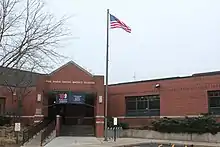
Two-hundred and five students in 5th through 8th grade attended Fox River Grove Middle School (FRGMS) in 2019. 53% of FRGMS students were proficient in math in 2019, and 55% were proficient in reading. The middle school's student to teacher ratio was 14:1.[38]
High schools
Most students in the village attend Cary-Grove Community High School located across the Fox River in neighboring Cary.[39]
Parks and recreation
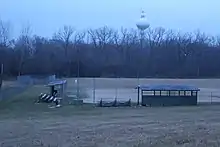
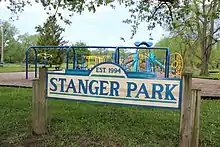
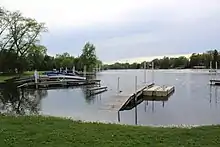
Over 100 acres in Fox River Grove are classified as public parks and open space. Between the village's 11 parks, access to playgrounds, basketball and volleyball courts, Port-A-Johns, sledding hills, baggo (cornhole) sets, soccer and baseball fields, picnic areas, fishing spots, hiking areas, and an ice skating area are made available to residents and visitors.[40]
The village's small size has inhibited it from being able to support an official park district, so recreational activities are planned and administered by the volunteer-run Fox River Grove Rec Council. Sporting opportunities offered by the Council include a men's basketball league, an adult volleyball league, and a youth soccer program. Youth baseball, softball, and basketball leagues are administered by Cary-Grove organizations.[41]
During the annual Fireworks Celebration (always on the Saturday after the 4th of July), Fox River Grove shoots off fireworks from 30-acre Picnic Grove Park.[42] Also in July, Picnic Grove Park serves as the "battlefield" for the Fox River Grove Fire District's water fights.[42]
The FRG Rec Council hosts its annual Fox Chase 5K in Stanger Park. A youth mile alternative is offered for youngsters.[43]
Lions Park, on the Fox River, provides scenic views of Cary. This waterside park is the site of Lions Fest, a yearly September festival in which Fox River Grove residents gather to converse and eat roasted corn. The lesser-known Arts & Crafts Fair is also hosted at Lions Park each July.[42] In 2019, the village celebrated its centennial. The highlight of this celebration was a temporary carnival installed at Lions Park.[44]
| Park name | Acres | Facilities | Neighborhood(s) |
|---|---|---|---|
| Picnic Grove Park | 30 | Sled hill, playground, volleyball court, Port-A-John | Picnic Grove |
| Foxmoor Park | 30 | Fishing holes, hiking trails, gazebo | Foxmoor |
| Victoria Woods Park | 22 | Grassy knoll | Victoria Woods |
| Hunters Farm Park | 15 | Baseball field, soccer field, playground | Hunters Farm |
| Old Hunt Park | 9 | Sled hill, baseball field, soccer field, snack shack, Port-A-John | Foxmoor |
| Spring Creek & Maple Parks | 9 | Fishing zone, hiking trail, picnic area | Hillview Estates, Konopasek, Maplewood Meadow Estates, Venetian Gardens |
| Algonquin Road & Stanger Parks | 7 | Soccer field, basketball court, ice rink (seasonal), sewage/runoff ditch, hiking trail, playground | Foxmoor |
| Lions Park | 6 | Fishing zone, picnic area, shelter, volleyball court, playground, sandy beach, basketball hoops, Port-A-John | Vorisek |
| Foxmoor Jaycee Park | 3.5 | Fishing hole, soccer field, basketball hoops, baseball field, shelter, picnic area, hiking trail, playground | Foxmoor |
| North River Parks | 1 | Fishing zone, playground, picnic area | 3 individual parks hugging the river's bank |
Environmental concerns
.jpg.webp)
Much of the Grove is located within the Fox River's floodplain. As a result, waterfront properties in the village are at risk of flooding.[45] Seasonal rains in the spring and summer often wash over the backyards and parks that line the river, resulting in property damage, erosion, and the spreading of trash and pollutants from the river onto land. In order to stymie erosion in 2020, the village dumped loads of rocks along a 500-foot stretch of riverbank in Picnic Grove Park. Some residents voiced concern that this would destroy the silty bank used by children as a beach; however, it was determined that covering the beach with stone was a necessary move to make in order to preserve the shoreline.
Business
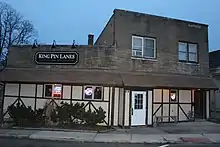
Built in 1924, King Pin Lanes became the first bowling alley to open in McHenry County.[46]
In 1955 Roy and Glenn Weber opened Weber Fuels Service Station and the 5th Wheel Bar and Restaurant on the corner of Rt 14 and Rt 22. The property was purchased by Shell in 1987.
In 2012, the village legalized slot machines.
There are two shopping centers: Stone Hill Center and Foxmoor Crossing. The centers contain several stores (Tuesday Morning and Walgreens) and chain restaurants typical of American suburbs. Jewel-Osco serves as the Grove's premier grocery store. In 2020, a Culver's replaced Mr. Beefy's hot dog shack on Northwest Highway.[47]
Transportation
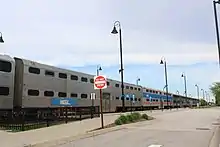
The main artery running through Fox River Grove is U.S. Route 14, also known as Northwest Highway. Those traveling north on Route 14 can access the cities of Cary, Crystal Lake, and Woodstock; cities along Route 14 found south of the village include Barrington, Palatine, Arlington Heights, Mount Prospect, Des Plaines, Park Ridge, and Chicago. Illinois Route 22 also passes through FRG, connecting the village to North Barrington, Lake Zurich, Long Grove, Lincolnshire, the Tri-State Tollway, Bannockburn, and Highland Park. Moreover, Algonquin Road allows Grovers quick access to the villages south of FRG including Algonquin, Lake in the Hills, and Carpentersville. FRG residents can make use of the MCRide system, a dial-a-ride service that offers rides between several McHenry County municipalities.[48]
FRG has one Metra station along the Union Pacific Northwest line which connects Harvard, Illinois to Chicago's Ogilvie Transportation Center. Non-express trips between the Grove and Chicago take about 70 minutes.
Sport
In 2017 Norge Ski Club ski jumpers Kevin Bickner and Casey Larson qualified for the Olympic team based on their performances in the World Cup, while Michael Glasder qualified by winning the Olympic Trial in Park City, Utah on December 31st.[49] The three jumpers from Norge Ski Club constituted 3/4 of the Men's Olympic Ski Jumping team in 2018, which made U.S. Olympic history by marking the first time three men from the same ski club represented the United States in ski jumping at the games.[50]
References
- "2019 U.S. Gazetteer Files". United States Census Bureau. Retrieved July 14, 2020.
- "Population and Housing Unit Estimates". United States Census Bureau. May 24, 2020. Retrieved May 27, 2020.
- "Geographic Identifiers: 2010 Demographic Profile Data (G001): Fox River Grove village, Illinois". U.S. Census Bureau, American Factfinder. Archived from the original on February 12, 2020. Retrieved December 10, 2012.
- | "Milwaukee Public Museum: Ojibwe History"
- | "Encyclopedia of Chicago: Fox River Grove, IL"
- | "Encyclopedia of Chicago: Ojibwa"
- "History of Fox River Grove"
- Hanna, Janan (June 12, 1993). "BOHEMIA MEETS MAYBERRY ON THE FOX RIVER". Chicago Tribune. Chicago. Retrieved January 9, 2020.
- | "Fox River Grove Historic Walking Tour"
- | "HISTORY OF ST. JOHN NEPOMUCENE CHURCH AND CEMETERY"
- | "Encyclopedia of Chicago: Fox River Grove, IL"
- | "The Digital Research Library of Illinois History Journal: Fox River Picnic Grove (Amusement Park) in Fox River Grove, Illinois. (1900 to Mid-1970s)"
- "Norge Ski Club"
- "Norge Ski Club trio officially named to Olympic ski jump team". Northwest Herald. Crystal Lake, IL. January 25, 2018. Retrieved January 14, 2020.
- Armstrong, Jim (February 10, 2018). "Michael Glasder, Kevin Bickner and Casey Larson fall short in normal hill ski jumping; German Andreas Wellinger wins gold". Chicago Tribune. Chicago. Retrieved January 14, 2020.
- "Louis' Place Crystal Ballroom"
- "About The Bettendorf Castle"
- Rowland, Brett (June 24, 2009). "'Public Enemies' and Fox River Grove's notorious history". Northwest Herald. Crystal Lake, IL. Retrieved January 14, 2020.
- Girardin, George Russell; Helmer, William J.; Mattix, Rick (2005). Dillinger: The Untold Story. Bloomington, IN: Indiana University Press. p. 340. ISBN 0-253-21633-8.
- Hlotke, Suzanne G. (September 20, 1994). "FOX RIVER HOMES OKD OVER PROTEST". Chicago Tribune. Chicago. Retrieved December 25, 2019.
- "Fox River Grove Code of Ordinances"
- Bustos, Joseph (January 2013). "Grease fire breaks out at New China in Fox River Grove". Northwest Herald. Crystal Lake, IL. Retrieved January 9, 2020.
- Rowland, Brett (November 17, 2014). "With help, New China Restaurant reopens in Fox River Grove after fire". Northwest Herald. Crystal Lake, IL. Retrieved January 9, 2020.
- | "Fox River Grove restaurant chemical spill sends 3 to hospital"
- "Fox River Grove's Centennial Celebration"
- "Fox River Grove becomes a debt-free community". Daily Herald. Arlington Heights, IL. December 4, 2019. Retrieved May 22, 2020.
- "G001 - Geographic Identifiers - 2010 Census Summary File 1". United States Census Bureau. Archived from the original on 2020-02-13. Retrieved 2015-08-03.
- "Census of Population and Housing". Census.gov. Retrieved June 4, 2015.
- "U.S. Census website". United States Census Bureau. Retrieved 2008-01-31.
- "Fox River Grove Profile"
- "Fox River Grove, IL Heritage: Foreign-Born Population"
- "Village Board of Trustees"
- "Fox River Grove Code of Ordinances"
- "McHenry County Pillars: Fox River Grove President Robert Nunamaker". Northwest Herald. Crystal Lake, IL. November 29, 2018. Retrieved July 22, 2020.
- Fox River Grove Memorial Library: Local History
- "Algonquin Road Elementary School"
- "Fox River Grove Middle School"
- "Fox River Grove Schools"
- "Parks & Recreation"
- "Fox River Grove Rec Council"
- "Events & Attractions"
- "Fox Chase 5K"
- Buchman, Cassie (August 24, 2019). "Fox River Grove rings in 100 years with centennial celebration". Northwest Herald. Crystal Lake, IL. Retrieved January 13, 2020.
- | "Vulnerability Assessment for the Fox River Corridor Plan
- Stearns Burgess, Nancy (June 9, 1996). "KING PIN LANES ROLLS INTO HISTORY OF FOX RIVER GROVE". Chicago Tribune. Chicago. Retrieved December 26, 2019.
- Bachman, Cassie (August 1, 2019). "Mr. Beefy's, Culver's land sale closes; demo could begin soon". Northwest Herald. Crystal Lake. Retrieved January 17, 2020.
- "MCRide"
- https://www.chicagotribune.com/suburbs/elgin-courier-news/ct-ecn-norge-parents-st-0124-20180123-story.html
- https://www.chicagotribune.com/suburbs/elgin-courier-news/ct-ecn-ski-jumpers-honored-st-0807-story.html

